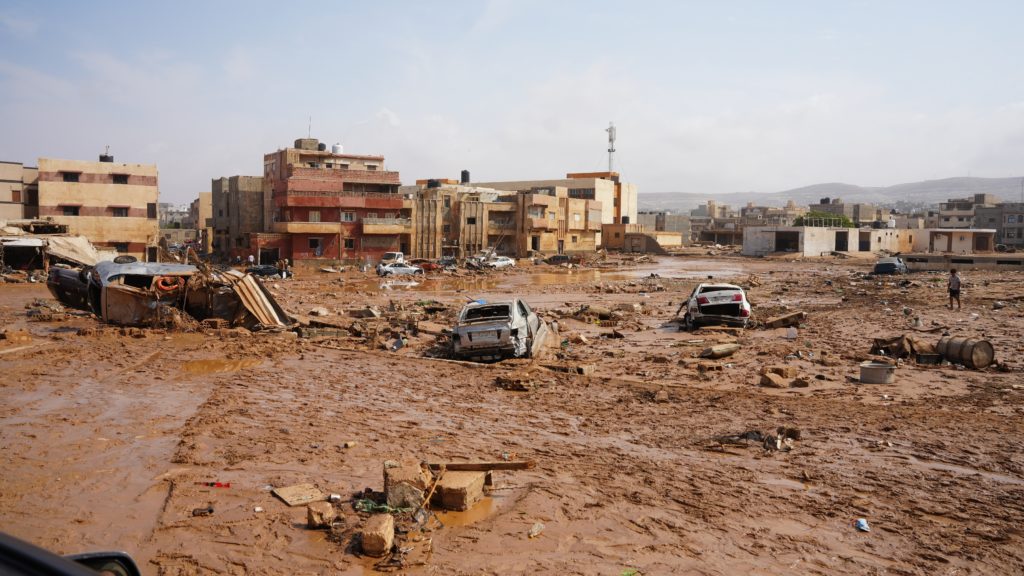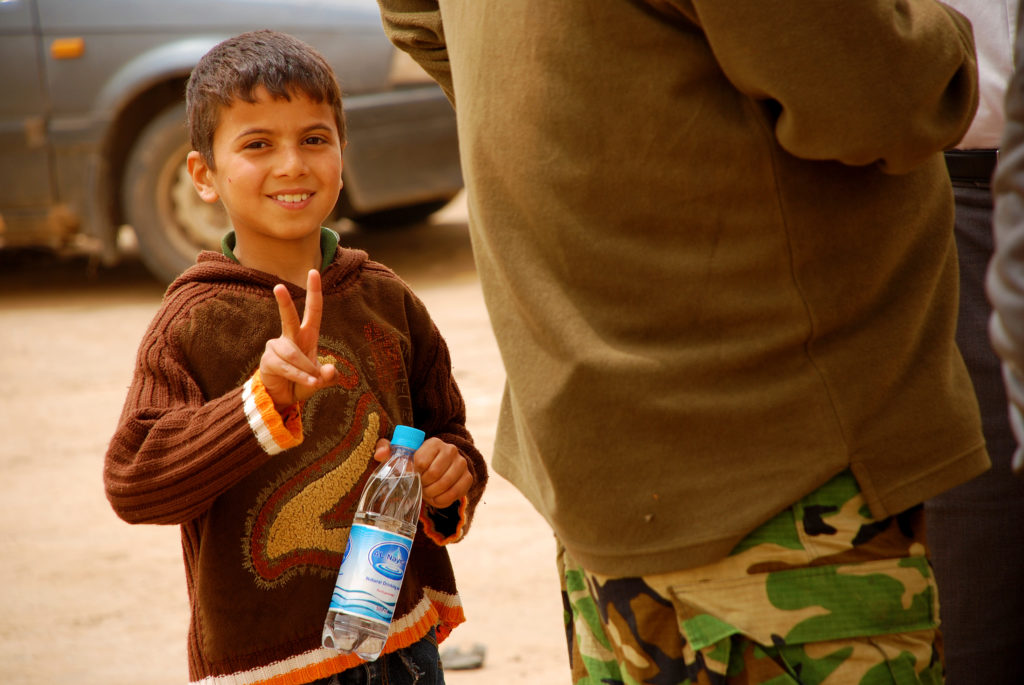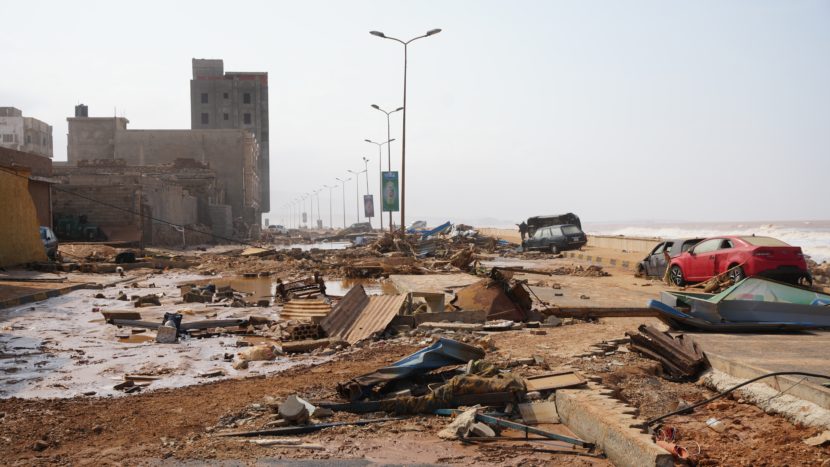On September 10, 2023, tropical Storm Daniel triggered the most devastating flood Libya has seen in more than a hundred years. The impacted regions, primarily the city of Derna, endured powerful winds and intense precipitation, resulting in the failure of two dams and disastrous inundation. This flooding wreaked havoc on residences, medical facilities, transportation networks, and electricity infrastructure. The loss of life has been measured in thousands, many of the victims being children, with thousands more unaccounted for, while the survivors have been caught in the nightmare of navigating the apocalyptic aftermath of the disaster.
Human victims and material damage following the floods
In the cities of Derna, Albayda, Soussa, Al-Marj, Shahat, Taknis, Battah, Tolmeita, Bersis, Tokra, and Al-Abyar, the heavy rains paired with the consequences of the dams collapsing have swiped away whole neighborhoods, resulting in entire families dying or going missing.
While numbers are still changing every day, according to the first estimates of the World Health Organization, over 4,000 deaths have been confirmed, and around 8,500 more people are considered missing (ReliefWeb, 2023). However, keeping in mind the amount of debris in the cities and fallen infrastructure, it is feared the number of victims could be multiple times higher.
Critical infrastructure has been destroyed or heavily damaged, which has affected the distribution of electricity and the normal functioning of telecommunications and health services. According to the latest reports, 84% of hospitals and 88% of primary health centers in the area affected by the floods are only partially functional or non-functional (ReliefWeb, 2023).
All of this makes the work of rescue teams more difficult, but it also means that the survivors cannot continue their lives in the area as it is. This is especially difficult for children whose lives have completely changed within hours.
Children’s lives caught in the tide of the floods
It is estimated that nearly 300,000 children were exposed to the storm (Unicef, 2023). The flooding itself lasted for about 15 hours. Being physically weaker compared to adults, children were especially vulnerable during this time, and humanitarian organizations fear that the death toll when it comes to children is measured in hundreds (Unicef, 2023).
Among those who survived, many witnessed their whole families dying. In many cases, they were stuck under the rubble and incapable of moving, spending hours next to the dead, known and unknown (Kouachi and Jamil, 2023).
Immediate psychological consequences are dire, according to psychologists and doctors who met surviving children and witnessed their distress. From depression over being speechless for weeks after the disaster to suicide attempts, these children whose family members, homes, schools, and neighborhoods disappeared in the muddy tide overnight are facing severe physiological damage and will require time and resources to heal (Kouachi and Jamil, 2023).
Displacement, health risks, and the struggle for survival

As the area has been devastated, more than 40,000 people have been forced to move, and at least 16,000 of them are children (Unicef, 2023). Many of them have nowhere to return, and what they knew as their homes and childhood have been swiped away.
Without any or with little belongings, often without parents or siblings, they found refuge in schools reorganized to provide shelter for the most affected ones and those who had nowhere else to go. As time moves on, a more permanent solution needs to be found, providing the bare minimum of conditions for these children to start healing.
However, on their way to psychological healing, thousands of survivors, including children, have been fighting an outbreak of waterborne and foodborne diseases caused by the lack of clean water and necessary hygiene conditions and spread by mosquitoes thriving in the stale water. Young children are especially vulnerable. Also, it is worth mentioning that around 9,000 children under the age of one in the area may be at risk of missing their regular vaccinations (ReliefWeb, 2023).
The previously mentioned condition of health facilities and the shortage of medical staff make treating those who are already fighting diseases or infections very challenging, further deteriorating an already critical situation. This is why it is of utmost importance to normalize the functioning of the healthcare system and enable children and adults to exercise their right to medical protection.
Educational disruption and the road to recovery
Another urgent issue is education. As the flood coincided with the beginning of a new school year, children in Libya started going to school one whole month later (Middle East Monitor, 2023). However, the solution for those in the area most affected by the floods is still not definite.
Among the 117 schools that have been affected by the floods, 44 have been seriously damaged and 4 have been destroyed (Unicef, 2023). As previously mentioned, many schools have been turned into shelters for the most affected, further reducing the current capacity of the educational system.
Having in mind the number of displaced people and school buildings that are out of use, overcrowded classrooms might become an issue. Also, working with children who have suffered trauma will require additional efforts by educational staff in already less-than-perfect circumstances.
Keeping all this in mind, it is clear that normalizing the educational system will require significant resources. It is important to note that this must be done promptly in order to avoid serious gaps and interruptions in the learning process. Also, going back to school is not crucial only from an educational point of view, but it is also an important step towards psychological healing, reestablishing connections with peers, and overcoming the trauma many of them share.
Importance of urgent reaction and joint efforts to help
Even though, unfortunately, many lives have already been lost, there is still a chance to help those whose lives have been disrupted, their homes washed away, and their futures left uncertain. The impact of disasters like this one on children can be profound, causing trauma, health risks, and disrupted access to education and basic necessities.
This is why it is vital for the government to allocate available resources for immediate medical and psychological care, set up temporary counseling centers, and collaborate with international organizations to provide food, water, medical supplies, and shelter for the most affected, focusing on children as an especially vulnerable group.
The international community and humanitarian organizations should help coordinate efforts and work with the government to assess children’s needs and implement mental health support. Also, they could facilitate the delivery of educational materials and establish temporary educational centers in locations where schools have been destroyed, enabling these children to continue their education. In addition, they can make a great impact on protecting children from exploitation and advocate for child-centered policies that would accelerate the recovery.
Finally, individuals can contribute by volunteering, offering support, and raising awareness of the situation in the area. Donating essential supplies, such as clean water, food, and clothing, to help meet the immediate needs of flood-affected families can also further enhance the community’s resilience during the challenging recovery process.
Humanium calls for us all to come together as a global community to provide immediate relief and long-term support to these children and their families. Together, we can rebuild their hope and their future.

If you want to contribute to Humanium’s own cause of helping children worldwide, please consider donating, sponsoring a child, or working with us as a volunteer. In this way, you can support Humanium’s continuous efforts to safeguard children’s rights, including their rights to life, protection, education, health, food and water, and give them a chance at a better future.
Written by Zeljka Mazinjanin
Bibliography:
Kouachi Ikram and Jamil Ahmed (2023), Derna children traumatized in aftermath of Libyan floods triggered by Storm Daniel. Retrieved from Andolu Ajansi at https://www.aa.com.tr/en/europe/derna-children-traumatized-in-aftermath-of-libyan-floods-triggered-by-storm-daniel/3003272, accessed on October 13, 2023.
Middle East Monitor (2023), Libya: Schools reopen in 15 flood-affected municipalities. Retrieved from Middle East Monitor at https://www.middleeastmonitor.com/20231002-libya-schools-reopen-in-15-flood-affected-municipalities/, accessed on October 14, 2023.
ReliefWeb (2023), Libya Flood Response Situation Report (11 October 2023). Retrieved from ReliefWeb at https://reliefweb.int/report/libya/libya-flood-response-situation-report-11-october-2023, accessed on October 13, 2023.
Unicef (2023), Libya Storm Daniel & Flooding Situation Report #4. Retrieved from Unicef at https://www.unicef.org/media/146041/file/Libya-Humanitarian-SitRep-05-October-2023.pdf, accessed on October 17, 2023.
Unicef (2023), More than 16,000 children are displaced following Libya floods. Retrieved from Unicef at https://www.unicef.org/press-releases/more-16000-children-are-displaced%E2%80%AFfollowing-libya-floods-unicef, accessed on October 13, 2023.
Unicef (2023), Nearly 300,000 children affected in Libya after Storm Daniel devastates entire communities. Retrieved from Unicef at https://www.unicef.org/mena/press-releases/nearly-300000-children-affected-libya-after-storm-daniel-devastates-entire, accessed on October 13, 2023.


